As a prepper it is important to be able to raise your own food. This includes raising livestock and processing their meat. Some of the most common type of livestock to raise and process are pigs, beef, lamb, and goat. Most of the animals are processed the same in the beginning, from culling to hanging them.
To begin you will need to cut the carcass in half. Use a bone saw and cut down the center of the backbone from the pelvis all the way to the neck. This will give you two halves to hang. After the carcass has been allowed to hang, then you will want to cut it into quarters.
This is done by taking the halves and cutting it between the 12th and 13th rib. You now have four pieces of carcass to work with. You have two forequarters, the front halves of the carcass, and two hindquarters, the back halves of the carcass.
Processing Individual Animals
Now, not all cuts of meat are created equal. You can make meat processing as easy as possible if your family just wants ground meat. If you want different cuts of meat, then you will need to learn the difference in the parts of the animal and the best cut for it.
We will discuss how to process the meat by working up individually the fore and hind quarters, this will be much easier to understand.
Related: Top 9 Animals to Raise in a Post Apocalypse World
By processing the animal yourself you get to cut to the thickness that you like for each piece. As you are butchering your carcass be sure to have totes or buckets for holding the separate cuts so you know what you are doing. It is simple to know that one tote is for grind only and the other is for cutting out your steaks or chops.
Pork
When you are processing a pig you can choose to skin it, or leave the skin on but remove all of the hair. I personally have always helped to skin it. I have never assisted in the hair removal of the pig. I do understand the reason and hope to one day try this method. The cuts of meat are juicier and flavorful with the hide on, as the lard cooks into the meat. Also, be sure to keep all of the fat that you can so you can render it into lard.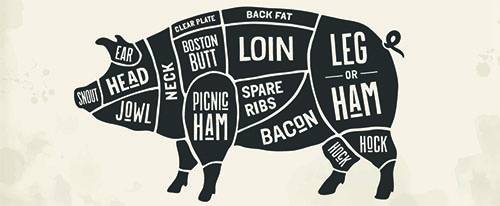 The forequarter has the boston butt or shoulder butt; this is where you will cut your shoulder steak and roast. The picnic ham is below the butt and you can cut out some spare ribs from the end of that cut. The scapula can be removed, and any bits of meat salvaged from that can be put up for grinding sausage.
The forequarter has the boston butt or shoulder butt; this is where you will cut your shoulder steak and roast. The picnic ham is below the butt and you can cut out some spare ribs from the end of that cut. The scapula can be removed, and any bits of meat salvaged from that can be put up for grinding sausage.
You will also be able to cut a roast; this cut isn’t as tender and therefore requires slow cooking. The jowl is also considered to be the pig’s cheeks. The jowl has several uses, from being enjoyed as a fatty bacon to flavoring beans and soups.
Related: How To Can Pulled Pork
The hindquarter has the rest of your spare ribs, which you can cut into smaller portions or leave as a whole rack of ribs. The belly is where you get your bacon.
The loin is one of the most desirable sections of the pig and located behind the boston butt. This is where you get your tenderloin from, pork chops, and loin roast. The loin also has country style rib cuts and several different chops you can cut from being loin chops and rib chops. The rib chop has a piece of the rib bone in it still.
The leg or ham is the rear of the pig. Here you will cut your ham into desired sizes, including bone in or boneless. You can also get some large ham steaks from the top of the leg. The top of the leg is also where you get the delicious cube steak cuts from.
When you remove the bones be sure to cut all of the bits of meat to grind into sausage. The back fat is above the loin and you will use that grinding into your sausage. The hock is the portion of the hog leg that is the knuckle. They are good for smoking and flavoring soup beans.
Beef
Beef can be used in about any dish. There are several different cuts of meat that you will get out of a beef and you can easily fill your freezer with one.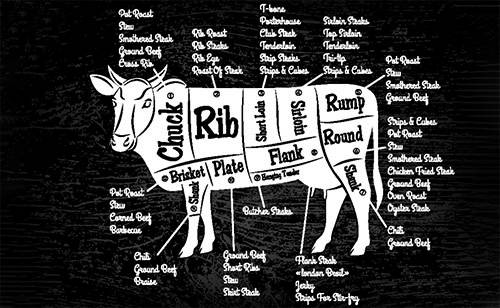 The forequarter is where you will get short ribs, roast, rib steaks, brisket and ground meat. You will also have some bones for flavoring soup bones. Start with removing the ribs from the chuck of the beef. Cut between the fifth and the sixth rib. Simply count them out and make the cut between them.
The forequarter is where you will get short ribs, roast, rib steaks, brisket and ground meat. You will also have some bones for flavoring soup bones. Start with removing the ribs from the chuck of the beef. Cut between the fifth and the sixth rib. Simply count them out and make the cut between them.
The chuck is the large cut at the front of the ribs. The chuck is a tougher cut and is good for making stew meat or roast. You can also grind it for burger.
Related: Pressure-Canning Hamburger Meat for Long Term Preservation
The ribs will be the sixth rib and back. You can cut out a rack of ribs with the larger ones and once you work back you can debone the smaller ribs for grinding. The meat above the rib is very tender and is where you can get your ribeye steak and rib roast. Directly below the ribs is where you will cut out your short ribs.
The plate is behind the brisket and below the ribs. Here is where you will find the short rib area as it is with the ribs. The plate is fatty and has cartilage, so it can be cut for ground beef. It also provides the skirt steak. The skirt steak is a thin piece of meat inside the abdominal cavity, it is the diaphragm muscle. Due to the coarseness of the muscle this cut needs to be sliced against the grain of the meat.
The beef brisket is found below the chuck. The brisket is a tough cut of meat and is fatty but very flavorful. It is basically the chest of the cow and can be used for a pot roast or leave it for slow cooking and smoking.
Related: How To Preserve Beef in Glass Jars
The hindquarter is where you will get the most desirable cuts of meat, such as the T-bone steak and porterhouse steak. You also have your round roast in the hindquarter. The beef short loin is directly behind the ribs, so it is the first cut of the hindquarter. This cut provides the steaks; the amount depends on the thickness you choose.
You can cut three different cuts of steaks from the short loin. The first cut is the club or bone-in steaks. The center cut is the T-bone steaks and the last cut toward the end is where you get your porterhouse steaks.
The sirloin of the beef is a large section that goes from the thirteenth rib back to the hip bone, and from the backbone to the belly. The sirloin has the tenderloin, the top loin, and the bottom loin.
The tenderloin is the most tender cut of meat and where the filet mignon comes from. The tip of the tenderloin is actually in the short loin and is the filet mignon. The tenderloin can be cut into tender steaks or roast also.
The top loin will give you some good grilling steaks. These steaks aren’t as tender as those from the short loin. The bottom loin is where you can cut some meat for roasting or grinding.
Related: Canning Amish Poor Man’s Steak
The beef round is basically the rump of the cow. The round is divided into a top round and bottom round. The bottom round will provide you with the rump roast. The top round is a lean meat and the roast will cook slowly. You will need cut thin and against the grain for a more tender cut.
The flank is the bottom of the hindquarter. Here you will get the flank steak but it is very tough. The flank is also good for grind.
The shank is on the front and hindquarters. This is the leg of the animal’s thigh and is tough and full of connective tissue.
Lamb
When processing the lamb, you will cut off the neck. The neck is a longer muscle and can be used in soups.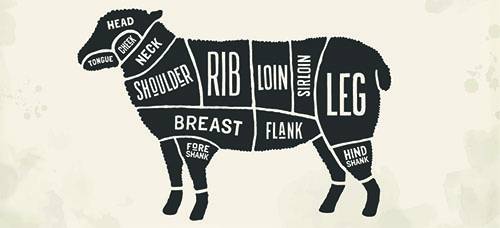 The forequarter of the lamb includes the shoulder, foreshank, and the breast. The shoulder will provide you with cuts of meat such as shoulder roasts, chops such as arm or blade chops, grind meat and stew meat. The breast of the lamb can be cut into a roast. Riblets can be cut out of the rib portion of the breast cut.
The forequarter of the lamb includes the shoulder, foreshank, and the breast. The shoulder will provide you with cuts of meat such as shoulder roasts, chops such as arm or blade chops, grind meat and stew meat. The breast of the lamb can be cut into a roast. Riblets can be cut out of the rib portion of the breast cut.
You can also cut the breast into stew meat and grind it too. The shank of the lamb is the top portion of the leg and thigh. The shank of the lamb can be removed and saved for slow cooking into stew meat and once the shank is removed you can make a boneless roast.
Related: This Super Root Preserves Meat Indefinitely!
The hindquarter of the lamb includes the rack, loin, leg and flank. The rack is the rib section of the carcass. Cuts of meat from the rack include rib roast, rib chops, and riblets. Removing the backbone is going to allow you to cut up the carcass easier and just deal with the rib bone and meat. Remove the meat from the vertebrae for grinding later.
Removing the ribs from the meat is going to give you the boneless roast as you roll it into itself, and will have the boneless rib roast. The loin is behind the rack and is where you get cuts of meat, such as loin roast and loin chops. You can cut the bone out and make a boneless cut.
The lamb leg is where you will get a large selection of cuts of meat. The leg includes the sirloin section of the lamb and is the front of that cut. Here you will be able to cut the sirloin roast or sirloin chops from. The center of the leg can be cut into center chops and you can remove the shank and have a roast that way. Lamb cube steak also comes from the leg.
A lamb is a small animal to butcher, so to be able to process it you may not have to split it into quarters to work.
Goat
Processing a goat is much like processing a lamb. The goat has the same cuts as a lamb with shoulder, breast, ribs, loin, leg, and shank. Depending on the breed, the goat can be a small to a very large animal. The amount of meat you get is determined by this.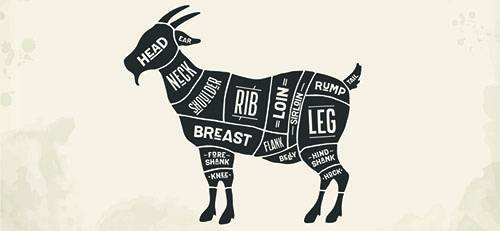 The forequarter of the goat is the shoulder and here you will get roast and some chops. The breast is below the shoulder and a fattier cut of meat. The breast will provide roast, small cuts for stew and you can grind the bits of meat.
The forequarter of the goat is the shoulder and here you will get roast and some chops. The breast is below the shoulder and a fattier cut of meat. The breast will provide roast, small cuts for stew and you can grind the bits of meat.
The hindquarter of the goat will be the ribs, which will provide you with a rack of ribs or riblets and you can also debone the ribs and make a roast. Be sure to save all the bits of trim for grind.
The loin will provide you with some loin chops and roast. The tenderloin of the goat is part of the loin and the leg. The leg will give you cuts of meat such as cube steak from the top, where it is more tender and you can get chops and roast.
Related: What Foods Can You Bury Underground For Winter?
A lot of the time people will leave the goat as just a cleaned carcass and will smoke the goat as a whole.
As a prepper, we do not like to waste. Be sure to keep any of the usable organs that you will eat or that you can feed to your dogs. Also, the hide can be used for several different things. Not all of the bones need to be discarded of either, as you have several options with making soup bones and boiling for broth.
You may also like:
How To Stockpile Lar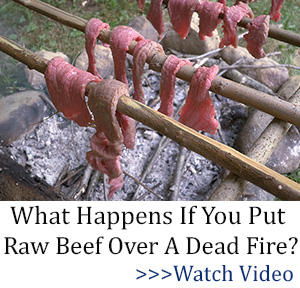 d, The Calorie Rich Survival Food Of The Great Depression
d, The Calorie Rich Survival Food Of The Great Depression
This Homemade Device Can Power Up Your Entire House 7 Days In A Row (Video)















Thanks for sharing. Going to print this one. Just don’t understand the most cut up animal of them all as far as private butchering. That would be deer. But it does say animals being raised on your property. So good job on this article.
After taking our animals (beef, pork) to local slaughter houses for years with mixed results, I finally decided to do it all here on the place. Added a 12×20 room on the back of the garage with a homebuilt 6×6 walk-in cooler (Window AC with a Coolbot), we now do it all at home.
Bought a cheapy bandsaw, a good grinder, and a good vacuum sealer and really like the results. I can take my time, get the cuts the way I want, save a LOT of what used to go in the scrap barrel at a processor for dog food, or render lard, etc. Gotten into curing my hams, bacon, making different sausages….it truly is great.
Doing it yourself also prevents things from getting mixed with other people’s meats, and ensures that you get all your suet, bones, marrow, the intestines (needed for sausage making), the offal, even the hooves (glue), and hide. Those are things you don’t always get to keep, if someone else does it for you.
Have to agree McGlik. My husband had a deer processed in Colorado after a trip with friends. He finally came home with a beautifully mounted head and ice chests of meat. I’d have given anything to have more to work with.
Hooves add collagen to your bone broth – definitely keep the hooves!
Saving article to send to a friend. Well explained.
When I was butchering a sheep we cut the ribs loose along the sides of the backbone and used the spine from neck to tail as stew meat. Just cut to lengths as desired. There’s a lot of good meat all around the spine and stewing till tender with hominy and onions, garlic, red or green chili and seasoned to taste sure made my family happy.
I always slit the throat, hung the carcass on a hook that had grown into my ancient Spanish seeding apricot tree. Let it bleed out then get busy. Gutted, skinned, cut apart at joints before laying on a canvas to finish processing. Head was skinned for roasting. Natives here eat it eyeballs and all. Organs cut apart and covered. Small intestines washed till spotless clean. Some I saved some for a scrap sausage while the rest were deep fried by native friends and called twisters. They always asked for some so I shared. My kids would wash them but weren’t fond of eating then.
We really enjoyed fresh mutton cooked over a juniper wood fire. Any thick sliced or diced summer squash, coursely chopped onions, and a bit of roasted, peeled , green chili peppers, cilantro leaves chopped, salt from a regional tiny salt lake freshly ground, some crushed dried juniper berries all fried together made the perfect easy side dish. Fry bread or thick camp bread made in a frying pan and something to drink and you had a great cookout meal.
Usually a sheep here was just cut apart at the joints. Parts with lots of meat that weren’t going to be roasts or cut up for stews were cut with a think fillet knife. The flesh was cut in thin sheets like enrolling it. It was ready to cook quick on a camp fire or in a frying pan, dry as jerkey, or cut up a bit more and drop in a stew. Ribs were roasted over the coals of a hot juniper fire with larger branch pieces fed as needed to keep hot coals and not so much high flames. Crusty ribs right off of the fire were a treat pulled or cut apart and served quickly. Legs were oven or pit roasted for an extended large family meal.
For Easter I sometimes cut up a whole sheep and started cooking thick legs and ribs wrapped in foil till nearly done then finish browning over hot coals at the after church cookout the thinner pieces were cooked quickly along with burgers and hot dogs when it was about time to serve. Salads, cooked squash, pots of chili stews and quick breads made for memorable feasts here in the reservations areas. A few men would go ahead to set up a place to cook and get the fire stated and gather more wood to keep both cooking and rock ringed campfires going till evening. Musicians played and sang, families played baseball if we could find enough open area, some of us climbed and explored. Everyone enjoyed roasting marshmallows then we drowned and put out any fire and hot coals and burry it a foot deep to be sure it was safe. Pick up trash and all head home. Usually most of a sheep plus hamburgers and hot dogs were consumed in the day by nearly 100F people from all the extended families gathered for the afternoon or sometimes a sunrise service, breakfast and lunch then we’d all head home to rest after a group baseball game. Most of the women still played as good as the men so it was a fun game.
Thanks for stirring up a good memory.
My friend has been looking for the pictures about butchering so thanks.
I still have a large commercial meat slicer from when I ran a summer camp here on my land years ago. I used it a lot for a few weeks each summer. I Closed the camp and K-12 school in 2004 and by 2005 I was living in town working to pay off bills and catch up property taxes. I just moved back in the winter of 2016-17. The slicer still works as good as it did when I bought it in 2001. But I have no use for it now. A band saw I could see using for either wood working or butchering.
What I’m wishing to replace is my deep throated scroll saw. I found a way to have infinite speed control on my old one so I could cut sheet silver or bone for jewellery making for my son and daughter, and wood items and copper sheet for enameling for my hobbies.
Which one is for deer?
So nothing about more common animals once shtf comes in earnest, when livestock is all gone.
Nothing about squirrels, deer, boars, elk, moose, bear, ducks, geese or anything else. Yeah helpful.
Great article, thank you
What about human cuts…..
That’s call long pig, if someone sells that I would think, WHAT!
in SHTF most people won’t have the place or equipment to process large animals other than field dressing and course butchering, so they, like me, will just bone out most of the meat from whatever animals are available and then try to dry / smoke / preserve by whatever means we can. This means you will need a good knife and sharpener, and hopefully have some cordage and tarp / cloth to wrap your meat to keep insects off until processed for storage.
If you have access to friendly folk that have their own supplies, you can always barter fresh meat for other foods and useful items, or even share and make friends / alliances (skills / labor) rather than let precious meat spoil, get infested by insects, or raided by other animals – including people.
I am curious as I skimmed through the article, most all the related articles for preserving had to do with canning or pressure cooking. I would like to know where we are supposed to get the jar lids. I grew up butchering and still do, we NEVER worried about named cuts of meat, if we wanted steaks and saw a good chunk we would cut steaks, we wanted roasts, we would cut them, and so on. Cut the animal to the way you consume your meat. Once you lay a half of hog on a cutting table and study the contour of that slab, you will start to see where and how to cut it. Same goes with cutting Deer, it isn’t complicated, mainly know where the most tender cuts come from and work accordingly.
Relying and using electric operated equipment in today’s society is fine, but make sure you have hand operated equipment too.
Hello Sawyer45306,
I agree with your “cuts” of meats, it is what you are used to doing and how you were taught about things.
As far as lids go, that should be part of your prep to get out to the next step, where we will come full circle, the build up of our civilization and then the return to a much simpler ways and times once again as our civilization falls.
So much will be lost in the coming fall of man, it is hard to think in terms of what we need to keep to get restarted, and what to rid our self of.
I believe that canning will be a useful methoid of food preservation, and the old style gaskets still work as well.
I did like you comment.
You can get bulk lids for canning. I have over 1000 lids for using, and I also have a lot of the reusable ones. I plan to stock more…just get a few each month. Build from there. Just like anything else you get for prepping.
Well Raven tactical… If you needed to eat humans after shtf this might help. Since what will be left to eat will likely be liberals, avoid anything to do with the head sinc there is nothing up there anyway. Big waste of time. And, since they are so FoS they will likely be far harder to clean than the effort would afford. You should be able to garner a great deal of lard from their fat posterior anatomy but be aware that the heat you will get from burning that could cause explosions as they are very volatile. Weak arms from lack of work and the fact that the rest of the body is likely filled with some medical drug due to the fact they can’t eat real food, they should be well preserved for a long period of time but again, not really worth eating. I wouldn’t waste my time.
Ultimate??? It’s four things! Four things that will be gone after year one after shit hits the fan! I found more on google images, and articles describing how to butcher other animals.
Pathetic article.
Instead of cursing the darkness why not light a candle. Write a better article. I am sure Claude would be happy to run a detailed, informative article on butchering and preserving various animals in an End of the World Situation. We are all here to learn, so enlighten us.
Personally, I printed this article out for my preppier manual. I would be happy to print out something that was more detailed or somehow “better”.
Wow, are you good! left coast chuck recommends you! Keep writing! niio